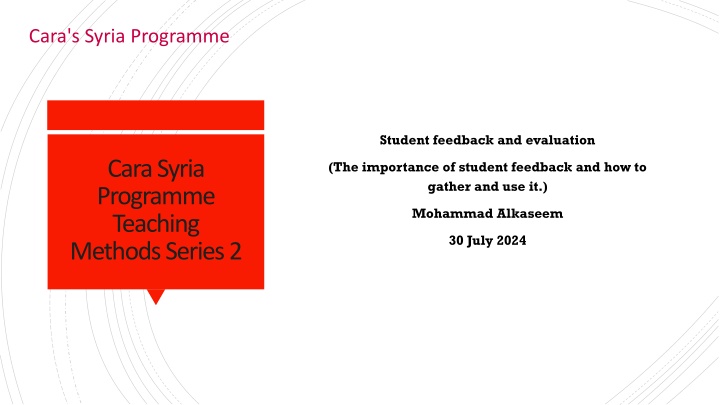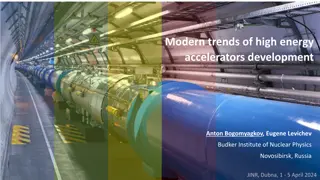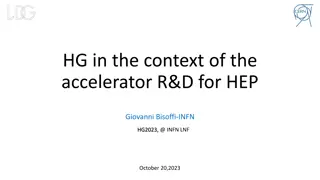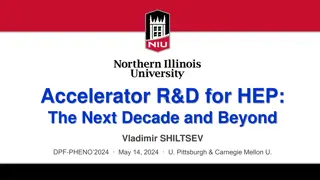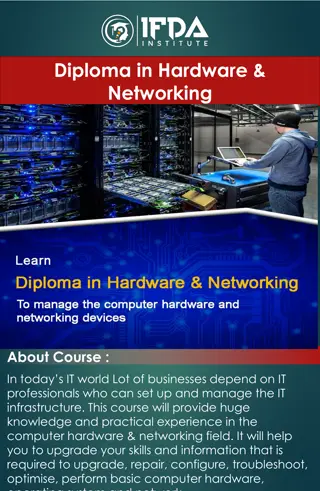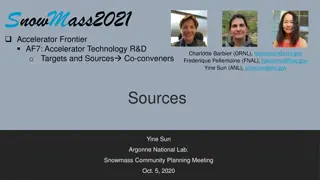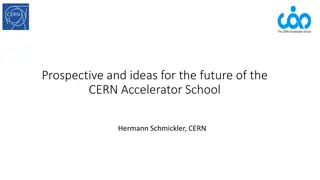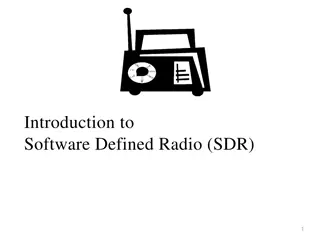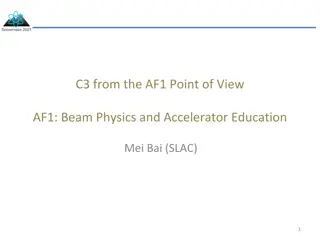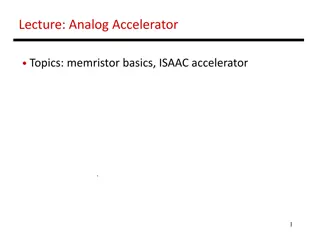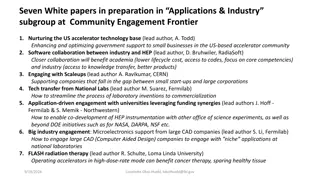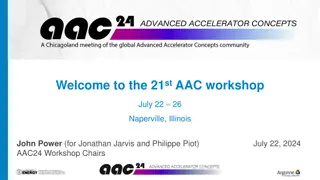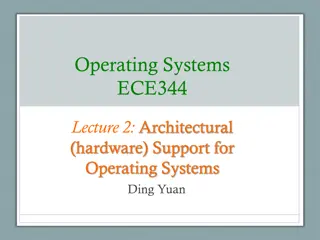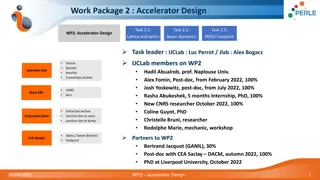Introduction to ICONE Accelerator Hardware Platforms
ICONE is a High Current Accelerator-based Neutron Source with great operational flexibility, developed by CEA/IRFU. The design is based on extensive accelerator experience, featuring low-energy 25 MeV current peak at ~80mA. The control system utilizes hardware platforms like LINAC, DTL, HEBT, LEBT, MEBT, RFQ. The standardized hardware platform, based on SARAF and IPHI upgrade, offers fast/semi-fast acquisition capabilities. Remote IOs, including Siemens and Beckhoff systems, enhance operations.
Download Presentation

Please find below an Image/Link to download the presentation.
The content on the website is provided AS IS for your information and personal use only. It may not be sold, licensed, or shared on other websites without obtaining consent from the author.If you encounter any issues during the download, it is possible that the publisher has removed the file from their server.
You are allowed to download the files provided on this website for personal or commercial use, subject to the condition that they are used lawfully. All files are the property of their respective owners.
The content on the website is provided AS IS for your information and personal use only. It may not be sold, licensed, or shared on other websites without obtaining consent from the author.
E N D
Presentation Transcript
Cara's Syria Programme Student feedback and evaluation Cara Syria Programme Teaching Methods Series 2 (The importance of student feedback and how to gather and use it.) Mohammad Alkaseem 30 July 2024
Student feedback and evaluation The importance of student feedback and how to gather and use it.
How has feedback impacted your learning or teaching experience? What challenges have you faced with traditional feedback methods? Your thoughts Which modern feedback approach do you find most effective and why?
Definition: Information and opinions provided by students about their learning experiences, course content, and teaching effectiveness. What is Student What is Student Feedback? Feedback? Purpose: To improve educational quality. Enhance student satisfaction. Inform teaching practices.
Enhances Teaching Quality: Identifies strengths and areas for improvement in teaching. Encourages reflective practice among educators. Improves Student Learning Experiences: Tailors learning to student needs. Enhances engagement and motivation. Importance of Importance of Student Feedback Student Feedback Informs Institutional Decision-Making: Supports curriculum development. Influences policy and resource allocation.
Empowering Students Gives Students a Voice: Makes them feel valued and respected. Encourages active participation. Leads to More Personalised Learning: Addresses individual needs. Supports diverse learning styles. Benefits for Benefits for Students Students Boosts Morale and Engagement: Shows that their opinions matter. Increases motivation and investment in their education.
Key Principles 1.Timeliness: 1. Provide feedback promptly to ensure relevance. 2. Helps students correct mistakes quickly. Principles of Effective Feedback 2.Clarity: 1. Ensure feedback is clear and understandable. 2. Avoid jargon and be specific. 3.Constructiveness: 1. Focus on providing actionable suggestions. 2. Encourage positive changes.
Professional Development Identifies Areas for Growth: Highlights strengths and weaknesses. Guides professional development efforts. Benefits for Benefits for Educators Educators Refines Teaching Strategies: Tailors methods to better meet student needs. Encourages innovative teaching practices. Provides Constructive Criticism: Supports reflective practice. Encourages continuous improvement.
Quality feedback loop
Google allows its employees to spend 20% of their time on projects that interest them, even if they are not directly related to their primary job responsibilities. This policy encourages feedback and innovation. Google's 20% Time Policy
How might you implement a similar feedback-driven initiative in your own teaching practices or departmental projects? Open discussion
1. Student-Led Research Projects Description: Students pursue research projects on topics of interest. Implementation: Allocate specific weeks for progress presentations and feedback. Benefits: Encourages independent learning and real-world application. 2. Innovation Time for Faculty Description: Lecturers develop new teaching methods or projects. Implementation: Faculty apply for "innovation time" grants; regular sharing sessions. Implementing Implementing Feedback Feedback- -Driven Initiatives in Teaching Initiatives in Teaching Practices Practices Benefits: Promotes professional development and continuous improvement. 3. Collaborative Workshops Driven Description: Bi-monthly workshops for solving real-world engineering problems. Implementation: Form multidisciplinary teams, periodic presentations, and feedback. Benefits: Enhances collaboration and practical problem-solving skills. 4. Feedback Loop in Course Design Description: Involve students in course design through surveys or focus groups. Implementation: Gather input at semester start; adapt curriculum based on feedback. Benefits: Makes learning relevant and engaging. 5. Peer Review and Mentorship Program Description: Peer review system and mentorship pairing. Implementation: Integrate review sessions; establish mentorship programs. Benefits: Develops critical thinking and communication skills.
1- Departmental Innovation Hub Description: Dedicated space for faculty and students' innovative projects. Implementation: Establish an "Innovation Hub," regular pitch sessions. Benefits: Encourages creativity and collaboration. 2. Continuous Improvement Program Description: Regularly collect feedback from stakeholders. Implementing Implementing Feedback Feedback- -Driven Initiatives in Initiatives in Departmental Departmental Projects Projects Implementation: Use surveys and focus groups; establish a review committee. Benefits: Ensures responsiveness and continuous improvement. Driven 3. Teaching Innovation Grants Description: Grants for faculty proposing innovative teaching methods. Implementation: Grant application process; regular progress check-ins. Benefits: Encourages experimentation and enhances education quality. 4. Industry Collaboration Projects Description: Partner with industry for real-world experience projects. Implementation: Develop partnerships and regular feedback sessions. Benefits: Aligns curriculum with industry standards. 5. Faculty Development Seminars Description: Regular seminars for faculty to share and receive feedback. Implementation: Monthly seminars focusing on teaching and learning. Benefits: Promotes continuous learning and improvement.
Surveys: Advantages: Can reach a large number of students; provides quantitative data. Disadvantages: May lack depth; potential for low response rates. Focus Groups: Methods of Methods of Collecting Collecting Feedback Feedback Advantages: In-depth insights; provides qualitative data. Disadvantages:Time-consuming; may not represent all students. Course Evaluations: Advantages: Structured feedback; easy to analyse. Disadvantages: May not cover all aspects of the course. Informal Feedback: Advantages: Continuous; can address issues promptly. Disadvantages: May lack structure and comprehensiveness.
Specific Questions: Avoid vague questions. Focus on specific aspects of the course. Balanced Response Options: Provide a range of answer choices. Include Likert scales for nuanced responses. Designing Effective Designing Effective Surveys Surveys Anonymity: Ensure responses are anonymous to encourage honesty. Pilot Testing: Test surveys with a small group before full deployment. Make necessary adjustments based on feedback.
Survey Questions to evaluate a course 1.How satisfied are you with the quality of teaching in your engineering course? (Scale 1-5) 2.Do you feel the curriculum is relevant to industry needs? (Yes/No) Example 3.What is your year of study? (1st year, 2nd year, 3rd year, 4th year) 4.Additional comments (open-ended)
Quantitative Analysis: Use statistical tools to interpret numerical data. Identify trends and patterns. Qualitative Analysis: Thematic analysis of open-ended responses. Look for recurring themes and insights. Analysing Analysing Feedback Data Feedback Data Triangulation: Use multiple methods to validate findings. Ensure robustness and reliability of conclusions.
Curriculum Relevance (Yes/No) Teaching Satisfaction (1-5) Response ID Year of Study Comments Good start to the course. 1 4 Yes 1st year Needs more practical applications. 2 3 No 2nd year Data collected (slide 17) Some courses are outdated. 3 2 No 3rd year Excellent preparation for career. 4 5 Yes 4th year Very satisfied with the teaching. 5 4 Yes 3rd year 6 1 No 2nd year Too theoretical.
Key Statistics: Teaching Satisfaction: Mean: 3.17, Median: 3.5, Mode: 4 Range: 4, Variance: 2.67, Std Dev: 1.63 Curriculum Relevance: Yes: 3, No: 3 Visualisations: Satisfaction Levels: Bar Chart Step-by-Step Analysis Curriculum Relevance: Pie Chart Sentiment Analysis: Positive: 3 Negative: 3 Themes: Practical applications, course updates, theoretical content Insights & Actions: Improve Practical Applications: Focus on 2nd and 3rd years. Update Outdated Courses: Ensure alignment with industry standards.
Steps to Implement Changes 1.Identify Key Issues: 1. Focus on significant feedback trends. 2. Prioritise actionable items. 2.Develop Action Plans: 1. Create specific plans to address issues. 2. Set realistic goals and timelines. Implementing Implementing Changes Based on Changes Based on Feedback Feedback 3.Communicate Changes: 1. Inform students about changes made. 2. Explain the reasons behind decisions. 4.Monitor and Review: 1. Continually assess the impact of implemented changes. 2. Adjust strategies as needed.
Exit Tickets: Short responses at the end of each class. In-person: Written on small cards. Online: Student poll, forum post, or chat box comment. Continuous Continuous Feedback Feedback Informal Check-ins: Regularly gather feedback through conversations. Address concerns and questions promptly.
: Class Topic: Thermodynamics At the end of each class, students write brief responses on small cards. Example prompts: "What was the most important concept you learned today?" "Is there anything you found confusing or need more clarification on?" "How do you plan to apply today's lesson in your future projects?" Example Example Student Response: "Today, I understood the laws of thermodynamics better. The second law, in particular, was clearer." "I'm still a bit confused about entropy. Could we go over that again?" "I plan to use the concepts learned today in designing a more efficient heat exchanger for my project."
Student Poll: Use an online poll at the end of the class session to ask similar questions. Poll Questions: "What key concept did you grasp today?" "What topic needs more explanation?" Forum Post or Chat Box Comment: Forum Prompt: "Reflect on today's class and post one thing you learned and one question you still have." Example: Online Online Implementation Implementation "Today, I learned how to calculate the efficiency of a thermodynamic cycle." "I still have questions about the real-world applications of these cycles in industrial settings."
Introductory Conversations Questions to Ask: What was your favourite learning experience in a classroom, and why? What class learning experience could be improved from the previous year or quarter? What was your best experience working in teams or learning remotely, and what contributed to that? Start Start- -of of- -Quarter Quarter Feedback Feedback Format: Students can answer individually or in small groups. A notetaker records ideas.
Small Group Feedback Sessions Conducted by a Trained Evaluator: Evaluator gathers feedback in the instructor s absence. Ensures unbiased and honest responses. Group Discussions: Students discuss in small groups. Reach a consensus on what contributes to learning and what can be improved. Mid Mid- -Quarter Quarter Feedback Feedback Summary and Consultation: Evaluator summarises responses. Presents them to the instructor in a private consultation.
Platforms and Tools Google Forms: Easy to create and distribute. Integrates with other Google tools. Canvas: Built-in survey tools for course management. Online Surveys Online Surveys Tools Tools Centralised data collection. PollEverywhere: Useful for real-time feedback. Engages students during class. Qualtrics: Advanced survey options. Robust data analysis features.
Effective Responses Respond Quickly: Aim to address feedback in the next class meeting. Shows students their input is valued. Consider All Comments: Group suggestions into three categories: Changes possible this quarter. Changes for the next course offering. Changes you cannot or will not make for pedagogical reasons. Responding to Responding to Feedback Feedback Inform Students: Address suggestions and explain any confusions. Discuss which suggestions will be implemented and why. Reiterate how students can help improve their experience.
Effective Responses Respond Quickly: Aim to address feedback in the next class meeting. Shows students their input is valued. Consider All Comments: Group suggestions into three categories: Changes possible this quarter. Changes for the next course offering. Changes you cannot or will not make for pedagogical reasons. Responding to Responding to Feedback Feedback Inform Students: Address suggestions and explain any confusions. Discuss which suggestions will be implemented and why. Reiterate how students can help improve their experience.
Common Challenges Low Response Rates: Solution: Encourage participation through reminders and incentives. Challenges and Challenges and Solutions Solutions Negative Feedback: Solution: Use constructive criticism to improve. Bias: Solution: Ensure diverse student participation to mitigate bias.
Leveraging AI Natural Language Processing: Analyse open-ended responses. Identify themes and sentiment. AI Tools for AI Tools for Feedback Feedback Collection Collection Machine Learning: Detect patterns and trends. Predict areas for improvement. AI Chatbots: Gather real-time feedback. Provide immediate responses to common queries.
Improving Course Content Situation: Feedback identified weaknesses in course materials. Case Study: Case Study: Institution A Institution A Action: Adjustments made to address these issues. Result: Significant improvement in student satisfaction and performance.
Enhancing Teaching Methods Situation: Continuous feedback loops were established. Case Study: Case Study: Institution B Institution B Action: Changes in teaching approach based on feedback. Result: Improved student engagement and learning outcomes.
Email Feedback: Personalised, detailed feedback. Audio & Video Feedback: Provides a more personal touch. Can explain complex points better. E E- -Feedback Feedback Techniques Techniques Screencasts: Visual demonstrations. Useful for step-by-step guidance.
Using Feedback for Growth Regularly Review Feedback: Identify areas for improvement. Continuous Continuous Improvement Improvement Adapt Teaching Strategies: Implement changes based on feedback. Engage Students: Involve them in the improvement process.
Active Participation Encourage Honest Responses: Create a safe environment for feedback. Engaging Students Engaging Students in Feedback in Feedback Show Appreciation: Value and act on student feedback. Implement Visible Changes: Demonstrate that feedback leads to real improvements.
Maintaining Standards Feedback Informs Accreditation Processes: Ensures compliance with standards. Institutional Institutional Accountability Accountability Maintains High Educational Standards: Continuous improvement through feedback. Engages Stakeholders: Involves students, educators, and administrators in quality assurance.
Key Points: Collecting and using student feedback is vital for improvement. Diverse methods and tools enhance the feedback process. Continuous review and adaptation are essential. Summary Summary Final Thought: Rethink and innovate feedback practices to better support students and educators in higher education.
Jonas Flod n (2017). The impact of student feedback on teaching in higher education. Assessment & Evaluation in Higher Education, 42:7, 1054-1068. Stanford Teaching Commons: Best practices for gathering summative feedback. Boud, D. (1995). Enhancing learning through self- assessment. Sources Sources Hattie, J., & Timperley, H. (2007). The power of feedback. Nicol, D. (2010). From monologue to dialogue: improving written feedback processes in mass higher education. Yorke, M. (2003). Formative assessment in higher education: Moves towards theory and the enhancement of pedagogic practice.
